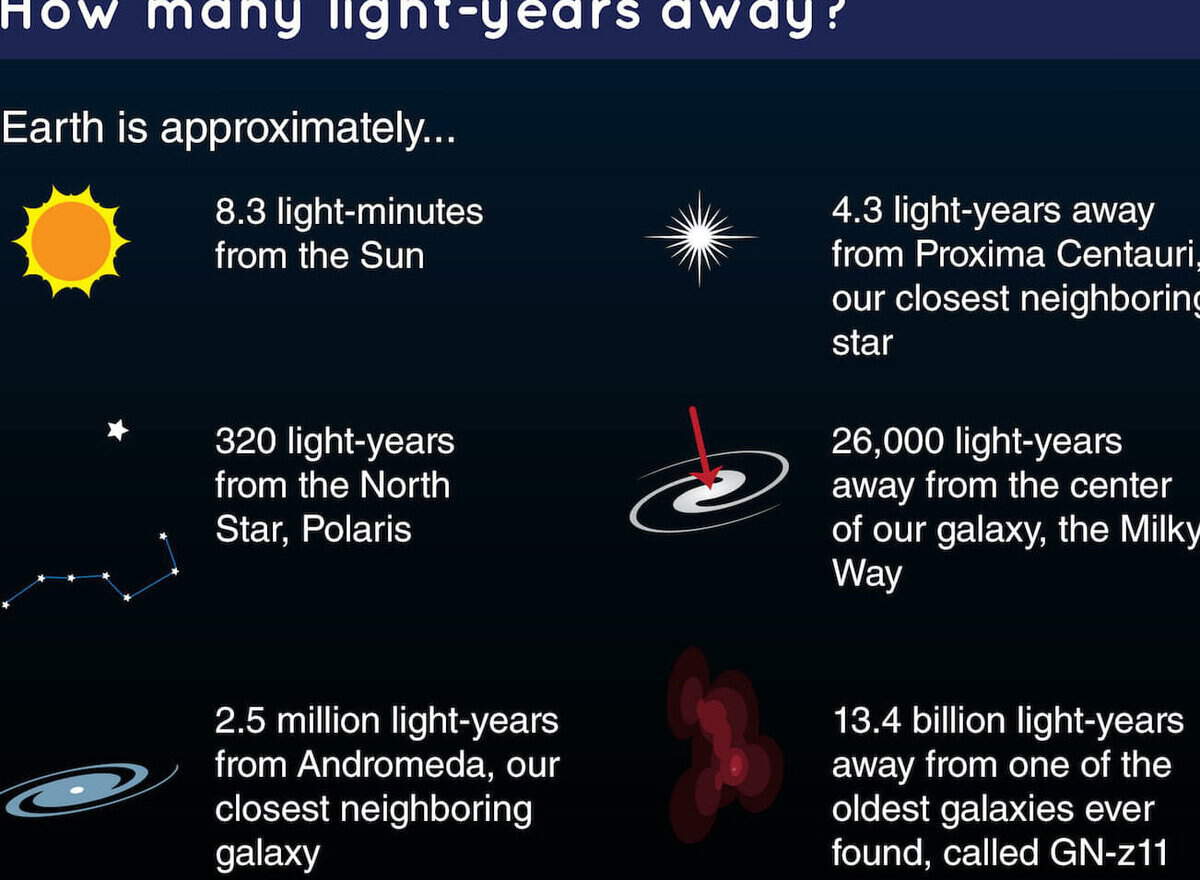Hello, esteemed readers of the KtoNaNovenkogo.ru blog. I’m sure all of you are familiar with the concept of a light year. The value of this measurement is truly fascinating.
Instead of measuring time or days, a light year is a measure of distance. According to the International Astronomical Union, 1 light year is equivalent to 9,460,730,472,580,800 meters (approximately 9.461 billion kilometers).
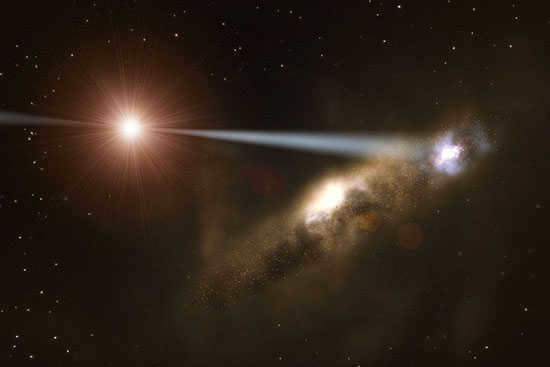
What is the purpose of utilizing this particular unit of measurement? The scale of the cosmos is so immense that attempting to use meters and kilometers would result in astronomical figures. As a result, the distance covered by a beam of light within a specific timeframe was chosen as a unit of measurement.
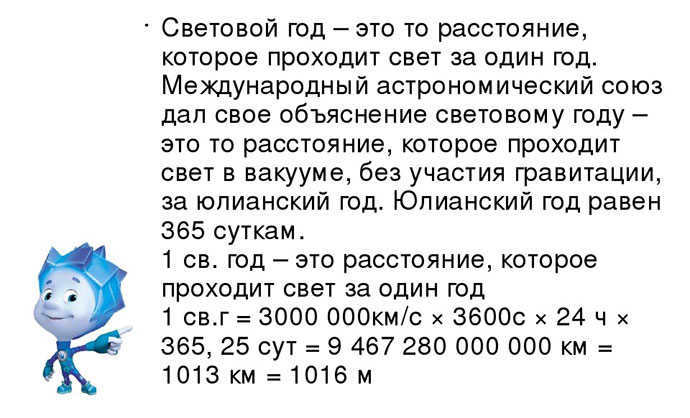
Take, for example, a man who decides to go to the store. He needs to cover a distance of two kilometers. However, his speed will vary throughout the journey. Initially, he may walk quickly, but as time goes on, he may start to feel tired. He may even encounter some unexpected events, like his shoelace coming untied or bumping into an old friend and deciding to walk at a leisurely pace.
On the other hand, a beam of light is much more disciplined in its movement. In a vacuum, it maintains a constant speed regardless of the distance traveled. It never tires, slows down, or accelerates.
The distance that light can travel in one minute is known as a light minute. Similarly, the distance covered in an hour is called a light hour. The largest distances in the universe are measured in light-years.
How the speed of light was calculated
In ancient times, it was believed by scientists that light in space traveled instantaneously. This belief was first questioned by Galileo Galilei, although he was unable to scientifically prove it. The first person to measure the speed of light was the Danish astronomer Olaf Remer in 1676. The measurements made during that time were not very accurate according to today’s standards, with a value of 214,000 km/s.
As time went on, the measurements were refined. In 1728, the English scientist James Bradley determined the speed to be – 301,000 km/s. Then, in 1849, the French physicist Armand Fizeau established that the speed of light was equal to 315,000 km/s. Finally, the Frenchman Leon Foucault achieved a measurement of 298,000 km/s.
Nowadays, the speed of light in a vacuum, which is approximately 300,000 km/second, is considered as the fundamental constant. This means that in just one second, a beam of light can travel a distance of 300,000 kilometers.
Facts about Light-years
For better understanding of space measurements, let’s take a look at some specific numbers:
1 light-year is equivalent to:
- 31,557,600 light seconds;
- 525,960 light-minutes;
- 8766 light hours;
- 365.25 light-days;
- 9,460,730,472,580,800 meters;
- 63,241.077 astronomical units (a.u.).
Furthermore, we can also express these figures in kilometers:
- During 1 light second, light covers a distance of 299,792,458 kilometers;
- Within 1 light minute, it travels an astonishing distance of 17,987,547.48 kilometers;
- The beam covers a distance of 1,079,252,848.8 kilometers in one light hour;
- In a single day of light, the beam travels a distance of 25,902,068,371.2 kilometers;
- Within the span of one light week, the beam covers a distance of 181,314,478,598.4 kilometers;
- Over the course of one light month, the beam travels a distance of 788,394,206,048.4 kilometers;
- One light-year corresponds to a distance of 9,460,730,472,580.8 kilometers.
Space exploration
The Earth-Moon distance is approximately 380,000 kilometers, which would take a ray of light just 1.3 seconds to travel. On the other hand, the distance from Earth to the Sun is about 150 million kilometers, and it takes light a little over 8 minutes and 18 seconds to cover this vast distance. This is enough time for someone to enjoy a cup of coffee.
At present, traveling at the speed of light is not feasible, except in the realm of science fiction. In reality, such high speeds would result in significant friction and other technical challenges. However, let’s imagine a scenario where we have a rocket capable of reaching the speed of light. In that case, interplanetary travel within the solar system would be as convenient as taking a taxi or a shuttle bus.
Traveling to Venus would take approximately 2 minutes to cover a distance of 40 million kilometers. Mars, on the other hand, would take an average of 3 minutes to cover a distance of 56 million kilometers. If we were to travel to Mercury, which is 77 million kilometers away, it would take approximately 4.5 minutes.
If we were to embark on a journey to Jupiter, which is approximately 587 million kilometers away, it would take us approximately 32 minutes to reach our destination.
But let’s push the boundaries even further. If we were to travel to Saturn, which is approximately 1.2 billion kilometers away, it would take us just over an hour to reach our destination. Uranus, on the other hand, is approximately 2.5 billion kilometers away and would take a little over 2 hours to reach.
However, if we were to travel to the edge of the solar system, known as the Oort cloud, it would take us approximately 4 years to reach our destination. Once there, we would be able to witness billions of comets.
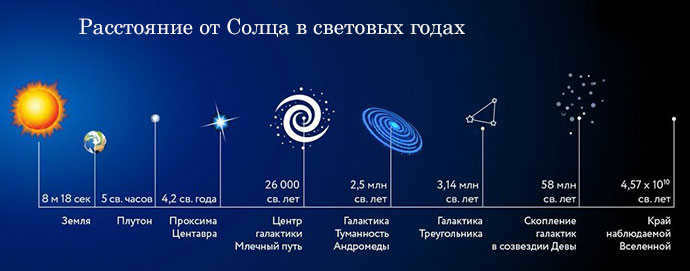
*If you tap on the image, it will expand to its full size in a new tab.
Heading towards the nearest star system. – Alpha Centauri is a little more than four light-years distant.. If you embark on a regular spacecraft, traveling at the orbital velocity of 16.7 km / s, the journey will last for 78 thousand years.
Additional numerical information.
The celestial bodies that we observe in the expanse above are located at distances of tens or even hundreds of light years. The distance from our location to the core of our galaxy, known as the Milky Way, is approximately 26 thousand light years. The Andromeda Nebula, on the other hand, is situated at a distance of 2.5 million light years. Notably, the edge of the Universe lies approximately 14 billion light years away.
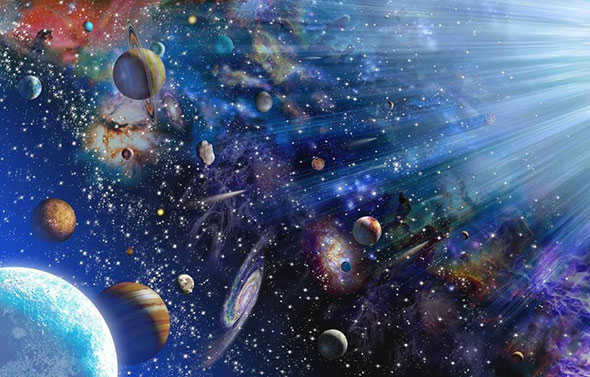
It is agreed that measuring such vast distances in kilometers is a challenging task due to the immense numbers involved. This is precisely why astronomers utilize light years as a unit of measurement for cosmic distances.
Fascinating trivia
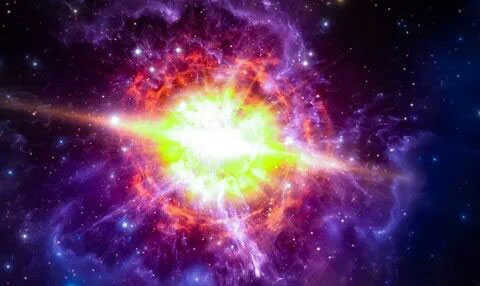

For instance, if a star explodes now in the constellation of Orion, which is located about 495 to 640 light years away, it would take approximately 500-600 years for the light from the explosion to reach Earth. As a result, we have the ability to observe light from a star that has already extinguished during the reign of Ivan the Terrible.
Best of luck to you! We hope to see you again soon on the pages of the KtoNaNovenkogo.ru blog.
This article is categorized under the following headings:
Feel free to leave your comment or review.
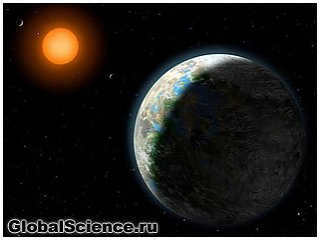
Scientists from the Pierre-Simon Laplace Institute in Paris, France, have published a study in The Astrophysical Journal Letters, discussing the potential habitability of planets in the solar system of the red dwarf star Gliese 581. Gliese 581 is one of the closest stars to our Sun in the galaxy. Previous studies have rejected two potential habitable exoplanets, but the team believes that the third planet, Gliese 581d, could be the first confirmed exoplanet where life similar to Earth’s could exist.
Is there any possibility of finding other planets similar to Earth, or at least suitable for habitation? Many astrophysicists have dedicated their efforts to locating planets similar to Earth within the “habitable zone” of stars, a region where temperatures are neither too high nor too low for life to thrive.
A team led by Stephen Vogt from the University of California, Santa Cruz, has made an exciting discovery: a new planet that they have named Gliese 581g, also known as “Zarmina’s World”. This planet is similar in size to Earth and is located within the habitable zone. For a few months, it seemed that we had found the first potential sister planet to Earth outside of our solar system. However, subsequent analysis by independent teams has raised doubts about the existence of Gliese 581g. Many scientists now believe that it may not be a real planet at all. The evidence that was initially thought to support its existence turned out to be nothing more than noise in the precise measurements of the star’s oscillations that were used to detect exoplanets in this system.
Recently, the scientific community has made an exciting discovery regarding the exoplanet Gliese 581d. Researchers from the Laboratoire de Meteorologie Dynamique at the Pierre-Simon Laplace Institute in Paris, including Robin Wordsworth and François Forget, have determined that Gliese 581d is a potentially habitable planet. This is significant because Gliese 581d is the older sister of Gliese 581g, another exoplanet in the same system. Although Gliese 581d shares similarities with Earth, such as its Earth-like characteristics, it is much larger and more massive. In fact, Gliese 581d has approximately seven times the mass of Earth and is twice the size of our planet.
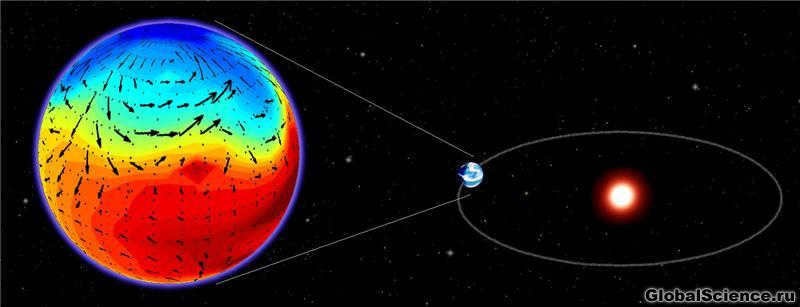
Scientists are thrilled by the fact that Gliese 581d is located just 20 light-years away from Earth and is considered one of our closest neighbors in the galaxy. Although, at present, it is not feasible to reach this planet, even the farthest man-made spacecraft, Voyager 1, would require 300,000 years to reach it. Nevertheless, future telescopes might have the capability to directly detect the presence of an atmosphere on Gliese 581d.
Source: Sciencedaily
Astronomers are searching for water in the atmosphere of exoplanet HAT-P-26b
Researchers at the Aerospace Research Center are investigating the recently discovered exoplanet with the aim of identifying drinkable water. This extraordinary exoplanet, which scientists have found, is situated approximately 437 light years away from Earth, in close proximity to the Virgo constellation. The planet orbits its star every 4.2 days. Scientists have determined that the star possesses a cloudy structure resembling the lower atmospheric layer of our own planet and exhibits a…
Scientists predict the imminent arrival of the malevolent planet Nibiru by the close of 2017

Astronomers are expressing concern over the behavior of Nibiru, a planet predicted to approach Earth by the end of the year, potentially leading to an apocalypse. The international scientific community has been increasingly discussing the existence of an unknown planet, referred to as Nibiru or planet X, which may collide with Earth in the near future. Scientists have called on NASA to acknowledge the existence of this planet.
An exoplanet may be located near planet Earth
In close proximity to planet Earth, there is a potential exoplanet that was initially discovered in 2007 and given the codename GJ 581d. However, a recent study has raised doubts about the existence of this celestial body due to an error in the decoding of the information used to identify it. In the search for the planet GJ 581d, scientists utilized a spectrometer capable of altering the planet’s color.
A hectare is a unit of area that is not part of the standard measurement system. It is defined as the area of a square with sides measuring 100 meters. Therefore, an area of 10,000 square meters corresponds to 1 hectare of land.
Fascinating fact: The International Committee of Weights and Measures first introduced the hectare in 1879. Nowadays, the hectare is widely accepted and used in conjunction with other units of the International System of Units.
Prior to the implementation of the hectare in Russia, different measures of area were utilized. For instance, the tithe was employed to indicate the area of large plots of land, which is approximately equivalent to a hectare. Other units of length were also utilized, such as the versta, which is equal to 1.6 kilometers. The sazhen measured 2.13 meters, the arshin measured 0.71 meters, and the vershok, one of the smallest units of length, was equal to 0.045 meters or 4.5 centimeters.
Converting square meters and hectares to hectares
In order to convert between square meters and hectares, it is necessary to perform some simple calculations. One hectare (ha) is equal to 10,000 square meters, and there are 100 hectares in 1 hectare. To convert from square meters to hectares, you can multiply the number of square meters by 0.0001, as one square meter is 0.0001 part of a hectare. Similarly, to convert from hectares to square meters, you can multiply the number of hectares by 10,000, as one hectare is equal to 10,000 square meters.
For example: Let’s say we have two plots of land with different areas. The first plot is 23 hectares, and the second plot is 350 square meters. To convert these areas to hectares, we can use the following calculations:
📌 When we multiply 23 hectares by 0.01, we get 0.23, indicating that there are 0.23 hectares in this plot;
📌 If we multiply 350 square meters by 0.0001, we obtain 0.035, meaning that this plot has 0.035 hectares.
You are aware that 1 hectare is equivalent to how many m² and how many acres are in one hectare. In order to perform the reverse calculations and convert the area of the plot from hectares to hectares and square meters, you also need to solve a simple example. One hectare contains 100 hectares, so to convert hectares to acres, multiply the area of the plot in hectares by 100. One hectare comprises 10,000 m², so to determine the area of the plot in m², multiply its area in hectares by 10,000.
For instance. We have three parcels of land. The first one measures 2 hectares, the second one measures 3.4 hectares, and the third one measures 10.6 hectares. In order to convert these areas to ara and square meters, we can follow these steps:
📌 Multiply 2 by 100 and 10,000 to obtain the numbers 200 and 20,000 – in a 2-hectare plot of land, there are 200 ara and 20,000 square meters;
📌 Multiply 3.4 by 100 and 10,000 to obtain 340 and 34,000 – in a 3.4-hectare plot of land, there are 340 ara and 34,000 square meters;
📌 Multiply 10.6 by 100 and 10,000 to obtain 1060 and 106,000 – in a 10.6-hectare plot of land, there are 1060 ara and 106,000 square meters.
By way of illustration, here are some simple calculations:
✅ 2 hectares equals 20,000 square meters;
✅ 50 hectares equals 500,000 square meters;
✅ 15 hectares equals 150,000 square meters;
✅ 24 hectares is equivalent to 240,000 square meters.
Naturally, it is more practical to utilize commonly used units of measurement rather than converting hectares to square meters or hundred meters. It is more efficient to express the area of vast parcels in square kilometers, medium-sized parcels in hectares, small parcels in hectares, and extremely small parcels in square meters. If needed, it is simple to convert from one unit of measurement to another using a calculator.
Methods for Measuring the Area of a Plot and Choosing the Proper Unit of Measurement
If you find yourself in need of measuring the area of a plot, there are three different methods that you can use.
👣 Method 1: Walking the Plot
This first method involves physically walking the plot in order to gather measurements. However, it is important to note that this method may not provide the most accurate data, as everyone’s step length varies. This method is best suited for calculating the area of a small plot, such as a specific section in a vegetable or fruit garden.
Method 2: Visually Marking the Area
An alternative method is to visually mark the area of the plot that you want to measure. By creating a square or rectangle shape, with sides that touch at a corner, you can then walk along each side and count the number of steps taken. With this information, you can begin your calculations to determine the area.
The average stride length for adults is 70 centimeters or 0.7 meters. To determine the length in meters, multiply the number of steps on one side of the rectangle by 0.7. Repeat the same calculation using the number of steps on the other side of the plot. Multiply the two values together to obtain the area of the plot in square meters.
For instance, suppose you want to find the area of a plot. After measuring it in steps, you discover that one side has a length of 56 steps and the other side has a length of 78 steps. Let’s calculate the length of both sides in meters:
Multiply the obtained values: 56 × 0.7 and 78 × 0.7. Consequently, the area of our plot is 2140 square meters. If we convert it to hectares, it becomes 21.4 hectares, and if we convert it to acres, it becomes 0.214 acres.
This method is not commonly used to calculate the area of complex geometric shapes, such as trapezoids.
📏 Use a measuring tape. This technique is faster and more accurate than measuring by steps. To determine the area of a plot, simply measure the sides of the plot with a measuring tape. Then, multiply the resulting values together to obtain the area in square meters.
If you need to calculate the area of a circular plot or another complex shape, utilize specific formulas designed for calculating area. For instance, to find the area of a circular plot, use the formula P=¼πd², where d represents the diameter and π is approximately equal to 3.14.
👷 Optimize the calculation done by surveyors. This technique of measurement necessitates financial resources – hiring surveyors involves expenses. However, it is the most precise method and eliminates the need for time-consuming calculations. Geodesists have the ability to accurately determine the area of a plot with complex shapes down to the nearest centimeter, which is particularly valuable in land surveying.
We have discovered that there are 10 thousand square meters in 1 hectare. In Russia, besides hectares, other units of area measurement are also used, such as square kilometers, ares, and square meters. The more commonly known and widely used term for ares is honeycomb. Each of these area measures is used in specific situations.
Square kilometers are the largest unit of area measurement used in Russia. They represent a square with sides of 1,000 meters, so in one square kilometer, there are 1,000,000,000 square meters. Square kilometers are used to calculate the area of cities, regions, districts, entire continents, and even the planet Earth. For example, the total area of our planet is 510,072,000 square kilometers. One square kilometer is equal to 100 hectares. Therefore, 1 hectare represents only 0.01 of one square kilometer.
Hectares are the second largest unit of measurement used in our country. It is primarily utilized for measuring the area of forests, agricultural land, fields for growing forage crops, and other non-residential land. Although it is rare, large plots of land can also be expressed in hectares – however, plots larger than 1 hectare are considered exceptions to the rule.
Ary The hectare is the most common and well-known unit of measurement, ranking third in size. It is equivalent to a square of land with a side length of 10 meters, making it equivalent to 100 square meters. One hundred hectares make up an area of one hectare. Hectares are commonly used to denote the area of land plots, such as small plots for personal agricultural use, plots in dacha settlements, and small towns. In all advertisements for land sales, the area of land plots is given in hectares.
Square meters is a widely used unit of measurement for area. It is commonly applied to calculate the size of various residential properties such as country houses, private residences, cottages, rooms, apartments, and townhouses. Additionally, square meters are also utilized to determine the area of commercial establishments like stores, warehouses, and production halls.
Are you curious about the content someone shares on their Instagram account, but you don’t want them to know that you visited their page? Do you want to view the stories of people you know without being detected? Or perhaps you need to keep an eye on your competitors’ page without them finding out? In any of these scenarios, you can rely on a valuable service specifically designed for users like yourself. With the assistance of the InstaNavigation service, you can anonymously browse Instagram pages without worrying about the account owner discovering your visit. This allows you to see the content people are posting at any time, while remaining anonymous. All you need to do to view someone’s stories or profile is to provide their username. Once you do that, you’ll gain access to their page, including their stories and regular posts.


Browsing Instagram Accounts Anonymously
What are the benefits of anonymous viewing of Instagram stories
- You can follow any account and stay updated on their posts.
- You can see what your friends, acquaintances, and interesting people are posting without creating your own account. This is particularly convenient for those who don’t want to go through the registration process or maintain a social media presence. It’s also useful for those who need to view specific information on an account.
- Complete anonymity is provided. The account owner will not be able to know that you are monitoring their page.
- The service is incredibly easy to use. Just enter the account name and you will have instant access to publications, stories, and other actions.
The InstaNavigation service operates 24/7, without any breaks or weekends. This means that you can browse Instagram profiles at any hour of the day or night, in complete anonymity. All you need is an internet connection and a device that can access the project’s website. Whether it’s a smartphone, laptop, or PC, you have the flexibility to use any gadget to explore the InstaNavigation service.

InstaNavigation: project features
This project stands out with its unique feature – users can access its functionality without the need to register. Not only does it offer incognito mode for viewing other users’ pages, but it also saves valuable time that would have been spent on registration.
There are several key advantages of this service:
- Multi-platform compatibility. This means that the project can be accessed from any browser on any device, making it convenient and accessible.
- Ability to view and download photos and videos.
- The service that enables you to monitor account changes is free of charge. This sets the project apart from other platforms that require payment for similar features.
- We guarantee complete confidentiality. As users are not required to provide their contact information or Instagram handle, it is impossible to trace your activity on someone else’s page. Your actions will remain undisclosed.
- The service offers a simple and user-friendly interface. The website’s navigation is intuitive and easy to understand for everyone.
Furthermore, our team is continuously working on improving the project’s performance and development. Thousands of users have already benefited from the opportunities we provide.

